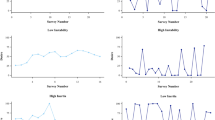Abstract
In a study conducted in 1978, using Spanier's (1976) Dyadic Adjustment Scale (DAS), couples in a sexually open marriage and couples in a sexually exclusive marriage were compared on dyadic adjustment. One hundred and thirty sexually open respondents were matched with 130 sexually exclusive respondents. It was found that there was no difference in response patterns between people in a sexually open marriage and those in a sexually exclusive marriage who were still living together with their spouses. On the other hand, persons who were no longer living together with their spouses, regardless of whether they were open or exclusive sexually, scored significantly lower on dyadic adjustment.
Similar content being viewed by others
References
Butler, E.W.Traditional marriage and emerging alternatives. New York; Harper and Row, 1976.
Buunk, B. Sexually open marriages: Ground rules for countering potential threats to marriage.Alternative Lifestyles 1980,3 312–28.
Cole, C.L., & Spanier, G.B. Comarital mate-sharing and family stability.Journal of Sex Research 1974,10 21–31.
Denfield, D. Dropouts from swinging: The marriage counselor as informant. In,Beyond Monogamy. Baltimore: Johns Hopkins University Press, 1974.
Gilmartin, B.D. Some social and personal characteristics of mate-sharing swingers. In,Co-marital sex: Recent studies of sexual alternatives in marriage. Boston: Little, Brown & Co., 1972.
Glenn, N.D., & Weaver, C.N. Attitudes toward premarital, extramarital and homosexual relations in the U.S. in the 1970's.Journal of Sex Research 1979,2 108–18.
Gough, H.G. Manual for the California Psychological Inventory. Palo Alto, California: Consulting Psychologists, 1957.
Kinsey, A.C., Pomeroy, W.B., Martin, C.E., & Gebhard, P.H.Sexual Behavior in the Human Female. Philadelphia: W.B. Saunders Co., 1953.
Knapp, J.J. An exploratory study of seventeen sexually open marriages.Journal of Sex Research 1976,12 206–19.
Knapp, J.J., & Whitehurst, R.N. Sexually open marriage and relationships: Issues and prospects. In R.W. Libby & R.N. Whitehurst (Eds.),Marriage and alternatives: Exploring intimate relationships. Glenview, IL: Scott, Foresman, 1977, pp. 147–60.
Paulson, C., & Paulson, R. Swing in wedlock,Society 1972,9 28–37.
Ramey, J.R. Intimate groups and networks: Frequent consequences of sexually open marriage.The Family Coordinator 1975,24 515–30.
Ramey, J.R.Intimate Friendships. Englewood Cliffs, NJ: Prentice-Hall, 1976.
Spanier, G.B. Measuring dyadic adjustment: New scales for assessing the quality of marriage and similar dyads.Journal of Marriage and the Family 1976,38 15–25.
Watson, M.A. Sexually open marriage: Three perspectives.Alternative Lifestyles 1981,4 3–21.
Author information
Authors and Affiliations
Additional information
The author gratefully acknowledges James R. Adams, Ph.D., for his part in the conduct of this research.
Rights and permissions
About this article
Cite this article
Rubin, A.M. Sexually open versus sexually exclusive marriage: A comparison of dyadic adjustment. J Fam Econ Iss 5, 101–108 (1982). https://doi.org/10.1007/BF01083247
Issue Date:
DOI: https://doi.org/10.1007/BF01083247




